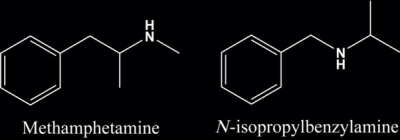N-ISOPROPYLBENZYLAMINE N-ISO TOXICITY

N-isopropylbenzylamine – a chain isomer of methamphetamine, has been used to adulterate methamphetamine, and distributed as fake methamphetamine by illicit manufacturers, leading to a world problem of N-isopropylbenzylamine exposure.
Though it is unclear whether N-isopropylbenzylamine has addictive potential like methamphetamine, N-isopropylbenzylamine users reported side effects such as headaches and confusion.
However, the pharmacological targets and cytotoxicity of this chemical remained unknown. In this study, in vitro toxicity of isopropylbenzylamine and its toxicity-related targets were investigated in SN4741, SH-SY5Y or PC12 cell lines that model neurons. The cell viability was analyzed by using MTT assay after incubation with N-isopropylbenzylamine for 24 h in cells. N-isopropylbenzylamine caused cell death with IC50 values at around 1-3 mM in these cell lines.
N-isopropylbenzylamine time- and concentration-dependently facilitated the expression of neuronal nitric oxide synthase (nNOS), and increased intracellular nitric oxide (NO) in SN4741 cells. Furthermore, 7-nitroindazole, a specific inhibitor of nNOS, significantly prevented N-isopropylbenzylamine-induced toxicity in vitro. These results suggested that N-isopropylbenzylamine-induced toxicity is at least partially related to the increased intracellular NO levels and the activated nNOS.
Considering the circumstances that N-isopropylbenzylamine was used to adulterate and mimic methamphetamine, and the side effects associated with N-isopropylbenzylamine in abusers, our findings sounded an alarm for abuser and warn the dangerousness of N-isopropylbenzylamine for public health.
N-Isopropylbenzylamine-induced conditioned place preference, sensitization behaviour and self-administration in rodents
N-Isopropylbenzylamine (N-ipb), a chain isomer of methamphetamine (METH) with similar physical properties, has been used as a substitute for METH in seized drug samples.
However, the abuse potential of N-ISO remains unclear. Therefore, this study aimed to evaluate the abuse potential of N-ipb in comparison to METH, by using conditioned place preference (CPP), locomotor sensitization and intravenous self-administration tests.
The results showed that N-ipb at a dose of 3 mg·kg-1 significantly induced CPP in mice, which was comparable to the effect of METH at 1 mg·kg-1 . Either acute or repeated N-ipb injections (1 or 3 mg·kg-1 ) failed to raise the locomotor activity. However, acute treatment with 10 mg·kg-1 N-ipb elevated the locomotor activity compared with saline, while chronic injection of 10 mg·kg-1 N-ipb induced a delayed and attenuated sensitization compared with 1 mg·kg-1 METH.
Rats could acquire N-ISO self-administration at a dose of 1 mg·kg-1 ·infusion-1 , and a typical inverted U-shaped dose-response curve was obtained for N-ipb. The mean dose of N-ipb that maintained the maximum response was greater than that of METH, indicating that N-ipb is less potent for reinforcement than METH.
In the economic behavioural analysis, comparison of essential values derived from the demand elasticity revealed that N-ipb is less efficacy as a reinforcer than METH. The present data demonstrate that N-ipb functions as a reinforcer and has a potential for abuse. However, the potency of psychomotor stimulation and the reinforcing effectiveness of N-ipb are lower than those of METH.

Question: is N-Ipb the same thing as N-iso?